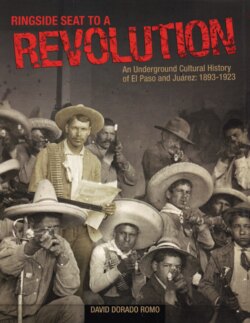Читать книгу Ringside Seat to a Revolution - David Dorado Romo - Страница 19
На сайте Литреса книга снята с продажи.
Оглавлениеrevolving sign board, an improved windmill attached
to a generator which harnessed wind into electricity,
and an adjustable clincher wrench he called “Ochoa’s
Chicken Pliers.” There were also several photographs
of a flying machine called the Ornithopter that Ochoa
built several years before the Wright brothers got their
own contraption off the ground at Kitty Hawk. At
first, this material seems to be merely a tangent—an
oddity that would make an interesting footnote, but
nothing very relevant to the main focus of my study.
If I were a mapmaker, these kind of details would be
the equivalent of small alleys or tunnels. Serious car-
tographers usually don’t waste their time charting
anything that’s not a main thoroughfare.
But sometimes the heart of the city can be found
not on a main street, but on a back alley. Ochoa’s
gadgets and contraptions led me in unexpected direc-
tions. They suggested other areas for me to explore—
the relationship between science, invention and rev-
olution, for instance. The Ornithopter offers a key to
Ochoa’s personality. It helps me understand some
other factors that propelled him—excuse the bad
pun—to become a revolutionary, that I wouldn’t
have gotten from newspaper articles or political writings.
History is full of apparently insignificant details
that have taken me to unforeseen terrain. During my
explorations I’ve dug up strange facts (and artifacts):
• An ad announcing a fight to the death between
a buffalo and a bull.
• A Manual for the Physical Inspection of Aliens.
• An El Paso mayor’s silk underwear.
• Halley’s comet.
• Zyklon B.
• A Mexican military band’s tour through the
United States.
• Astral projection.
All of these have led me to explore historical and
geographical zones I didn’t originally intend to even
visit.
ULTIMATELY, MICROHISTORY IS a method of
study that focuses more on the mysterious and the
poetic than on the schematic. “Microhistory and liter-
ature are twin sisters,” remarked Eric Gardel. It’s like
prospecting for gold or exploring underground
mazes—those honeycombed tunnels underneath
Oregon Street in El Paso’s Chinatown that the U.S.
customs officials raided during the turn of the century.
Elderly Chinese immigrants opened secret doors for
them. In one underground chamber the border agents
found cans of opium; in another, they found a young
man playing an exotic stringed instrument the
American officials had never heard before.
I too have found underground trails, forgotten
ancestors, lost photographs and music I had never
heard of before. This subterranean history is slowly
becoming the history of all of us.
DAVID DORADO ROMO
JULY 2005
14
